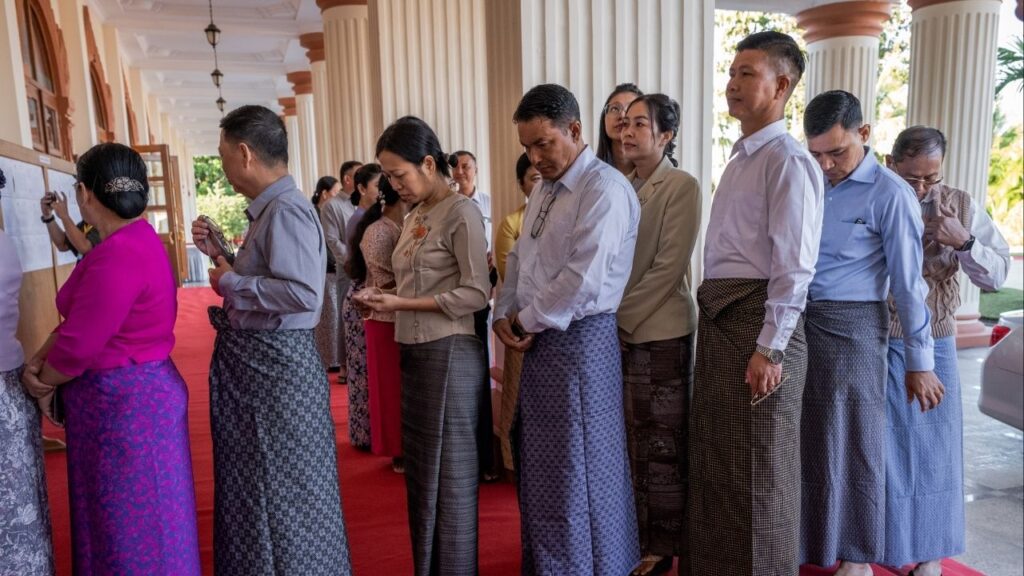Israel's National Security Adviser predicts the war with Hamas will extend through the year, as intensified fighting in Rafah exacerbates the humanitarian crisis and international tensions. (AP/Abdel Kareem Hana)

- Israel's National Security Adviser predicts the war with Hamas will last through the end of the year, extending the already eight-month-long conflict.
- The Israeli offensive in Rafah has caused heavy casualties and significant displacement, with recent strikes killing at least 37 people.
- The war has displaced most of Gaza’s population, leading to a severe humanitarian crisis.
Share
|
Getting your Trinity Audio player ready...
|
TEL AVIV, Israel — Israel’s war with Hamas is likely to last through the end of the year, a top Israeli official said Wednesday, a grim prediction for a war already in its eighth month that has killed tens of thousands, deepened Israel’s global isolation and brought the region repeatedly to the brink of a wider conflagration.
Israel Will Continue Their Offensive in Rafah
National Security Adviser Tzachi Hanegbi’s remarks were made as Israel was expanding its offensive in the southern Gaza city of Rafah, which has been the scene of intense fighting over recent days that has killed dozens, including displaced Palestinians. The military said three Israeli soldiers were killed on Tuesday, reportedly by a booby-trap that exploded inside a building.
Hanegbi told Kan public radio that he was “expecting another seven months of fighting” to destroy the military and governing capabilities of Hamas and the smaller Islamic Jihad militant group.
“The army is achieving its objectives but (it) said from the first days it was presenting its plan to the Cabinet that the war will be long,” he said. “They have designated 2024 as a year of war.”
Hanegbi’s remarks raise questions about the future of Gaza and what kind of role Israel will play in it. Already top ally the United States has demanded that Prime Minister Benjamin Netanyahu decide on a postwar vision for the Palestinian territory and his defense minister and a top governing partner have warned that he must take steps to ensure that Israel isn’t bogged down in Gaza indefinitely.
Related Story: Storm Damage Forces Removal of US-Built Gaza Pier for Repairs
War Has Already Displaced Most Palestinians
The war has already devastated Gaza’s urban landscape, displaced most of the territory’s population and sparked a humanitarian catastrophe and widespread hunger. It has opened Israel up to international legal scrutiny, with world courts faulting it over its wartime conduct, sparked disagreements with the White House, and prompted three European nations to recognize a Palestinian state against Israel’s wishes.
Israel says it must dismantle Hamas’ last remaining battalions in Rafah. It has also said it will seek indefinite security control over the Gaza Strip, even after the war ends.
Israel has yet to achieve its main goals of dismantling Hamas and returning scores of hostages captured in the Oct. 7 attack that triggered the war.
Beyond Rafah, Israeli forces were still battling militants in parts of Gaza that the military said it wrested control of months ago — potential signs of a low-level insurgency that could keep Israeli troops engaged in the territory.
Related Story: Taiwan’s Legislature Passes Changes Seen as Favoring China, Reducing ...
Fighting in Rafah Displaced 1 Million People
The fighting in Rafah has displaced 1 million people, the United Nations says, and Palestinians on Wednesday reported heavy fighting in different parts of the city. Most of the people who had been in Rafah had previously been displaced from elsewhere in Gaza.
Residents said fighting was underway in the city center and on the outskirts of Tel al-Sultan, a northwestern neighborhood where an Israeli strike over the weekend ignited a fire that swept through an encampment for displaced people, killing dozens. The military says it is investigating the strike and said the blaze may have been caused by a secondary explosion.
An expensive floating pier built by the U.S. to surge aid into the territory was meanwhile taken out of service by bad weather, in another setback to efforts to bring food to starving Palestinians. Gaza’s land crossings are now entirely controlled by Israel.
Related Story: Allies Debate Using Frozen Russian Assets as Ukraine Loses Ground
Palestinians in Rafah said thousands were still streaming out of the city, joining a mass exodus bound for crowded tent camps and areas devastated by earlier rounds of fighting. Many have already been displaced multiple times since the start of the war.
Saeed Abu Garad, a father of five living in the city center, said he had seen Israeli soldiers and tanks a few hundred meters (yards) from his home. “We are leaving today. The situation is extremely dangerous,” he said, adding that his neighbors have already left.
Ramadan al-Najjar, who fled to Rafah from northern Gaza earlier in the war and has been sheltering outside Tel al-Sultan for the past five months, said the fighting has intensified there in recent days.
“After heavy airstrikes, they began advancing, and tanks are now at the district entrances,” he said.
Israel Killed 37 Palestinians on Tuesday
Overnight and into Tuesday, Israeli shelling and airstrikes killed at least 37 people, most of them sheltering in tents outside Rafah, according to witnesses and health officials. The strikes occurred in the same area as the tent camp inferno, which has drawn widespread international outrage.
The Israeli military suggested Sunday’s blaze in the tent camp may have been caused by secondary explosions, possibly from Palestinian militants’ weapons. Rear Adm. Daniel Hagari, the Israeli military spokesman, said the munitions used — targeting what the army said was a position with two senior Hamas militants — were too small to be the source of the blaze.
The strike or the subsequent fire could also have ignited fuel, cooking gas canisters or other materials in the camp. The blaze killed 45 Palestinians, according to Gaza health officials. Netanyahu said the fire was the result of a “tragic mishap.”
The strikes over the past few days have hit areas west of Rafah, where the military had not ordered civilians to evacuate. Israeli ground troops and tanks have been operating in eastern Rafah, in central parts of the city, and along the Gaza-Egypt border.
U.S. and Allies Warn Against Full-fledged Offensive in Rafah
The U.S. and other allies of Israel have warned against a full-fledged offensive in Rafah, with the Biden administration saying this would cross a “red line” and refusing to provide offensive arms for such an undertaking. On Tuesday, U.S. State Department spokesman Matthew Miller gave no indication the administration sees Israel as crossing any of the red lines for Rafah, saying the offensive is still on a “far different” scale than assaults on other population centers in Gaza.
Last week, the International Court of Justice ordered Israel to halt its Rafah offensive as part of South Africa’s case accusing Israel of committing genocide against the Palestinians in Gaza, a charge Israel vehemently denies.
A proposed U.N. Security Council resolution demanding a halt to Rafah fighting was being circulated by Algeria on Tuesday, with plans to potentially bring it to a vote this week. The U.S. has vetoed multiple Gaza cease-fire resolutions.
The war began when Hamas and other militants burst into southern Israel in a surprise attack on Oct. 7, killing some 1,200 civilians and taking around 250 hostage. More than 100 were released during a weeklong cease-fire in November in exchange for Palestinians imprisoned by Israel.
Israel’s offensive in response to the attack has killed at least 36,096 Palestinians, according to Gaza’s Health Ministry, which does not distinguish between fighters and civilians in its count. Israel says it has killed 13,000 militants.
RELATED TOPICS:
Categories

Fresno Man Killed, Woman Injured in Mobile Home Park Shooting

In Myanmar’s Election, ‘Voting Out of Fear, Not Hope’

















